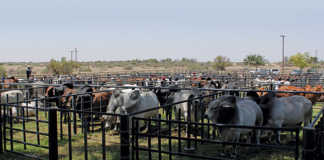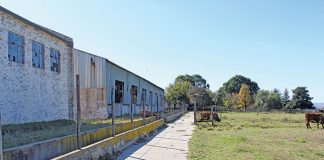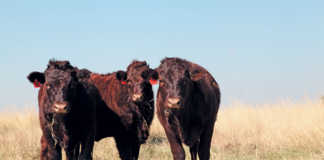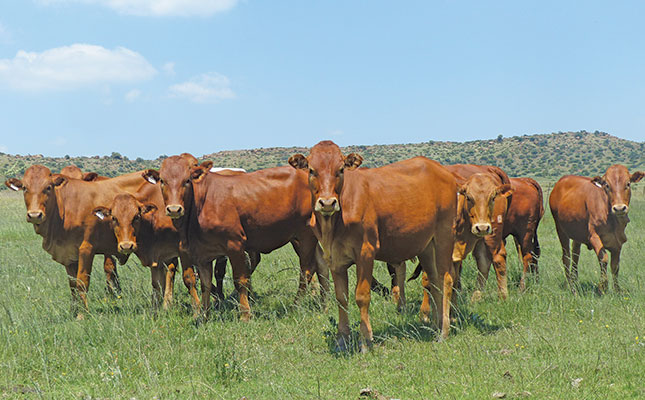
Photo: Mike Burgess
“The Afrikaner is a low-input animal with good-quality beef. Herein lies the real value of the breed,” says Jacquies Steenkamp, who registered his Derus Afrikaner Stud in 1996.
Today, he runs 240 Afrikaner female animals, half of which are registered, in the Rouxville district in the southern Free State, where they produce weaners almost entirely off the veld.
Steenkamp is highly committed to the breed and enthuses about its potential. A council member of the Afrikaner Cattle Breeders’ Society of South Africa, he says the breed offers superb business opportunities for the extensive beef farmer.
For example, the society registered Afri Beef as a quality free-range brand with the then Department of Agriculture, Forestry and Fisheries in 2016, and the brand won the People’s Choice Award at the 2019 African Livestock Trade Fair in Parys, Free State.
Steenkamp’s late father, Piet, ran a commercial Afrikaner herd near Vredefort in the Free State, and Steenkamp completed his BSc Agriculture, majoring in animal husbandry and genetics, at the University of the Free State in 1993.
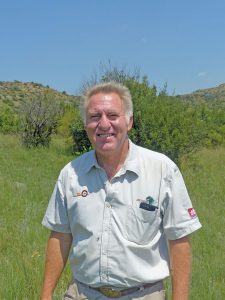
He, too, had become drawn to the breed by then, so after a few years in a mixed cropping/livestock operation with his brother, André, in the Klerksdorp district of North West, he registered the Derus Afrikaner stud.
The foundation animals were from proven dam lines used by his father, while a process of genetic infusion using Bonsmaras helped him broaden diversity. Over the years, he sourced more Afrikaner bloodlines, including from the Cronjé and Ras families in Theunissen/Winburg and Hoopstad respectively.
In addition to his work on the stud, Steenkamp experimented with a European and an indigenous synthetic beef breed, comparing the performance of these breeds under the same conditions.
Unfortunately, rampant stock theft on his Klerksdorp farm made running cattle too difficult, and in 2008 he bought the 1 680ha farm Tierhoek in the Free State district of Rouxville.
Here, he expanded his Afrikaner herd and did away with the two other breeds, which had struggled to utilise all grazing on the rugged Tierhoek and cope with Karoo paralysis tick (Ixodes rubicundus) loads.
In time, Steenkamp augmented his landholding with 300ha of leased land, and today runs a mixed livestock operation comprising Afrikaner cattle, 250 Merino Landsheep x SA Mutton Merino ewes, and a further 50 cows and 150 ewes that are leased to local farmers.
Sorghum, rye and oats (20ha of each) are grown as forage, but this is distributed selectively: the weaned Afrikaner heifers and selected bulls spend three months on the sorghum and green feed in winter, and the rest of the forage is reserved for the sheep.
Well adapted
Steenkamp’s Afrikaners are medium-framed, with cows weighing an average of 480kg. This, plus excellent walking ability, enables them to navigate the difficult terrain with ease.
“Here, cattle must walk up and down valleys and mountains,’’ he says, pointing across Tierhoek. “My Afrikaners do that well.”
The animals’ ability to reach all available veld has become invaluable during the drought that has assailed the Free State since 2014, as it minimises the need for supplementary feed.
Steenkamp’s Afrikaners receive nothing more than a protein lick in winter and a phosphate/salt lick in summer, yet outperformed the two other breeds on Tierhoek.
These did not have the Afrikaner’s walking capability and thus tended to overgraze the veld at water points and the immediate surrounds, to the detriment of their condition.
Another Afrikaner strength is its ability to cope with tick-borne infections. Steenkamp dips his cattle only after the first frost in late March/early April, and again a few months later, in contrast with the every 10 and 30 days respectively for the European and indigenous synthetic breeds he ran earlier.
Selection
Steenkamp bases his stud selection on functional efficiency, adaptability to veld conditions, and fertility before considering best linear unbiased prediction (BLUP) breeding values.
He does not deny the value of BLUP, but stresses that it should never be used in isolation.
“Take growth, for instance. If you just go on figures, you’ll breed a big animal that’s not adapted to the environment and will probably have calving problems. Everything must be in balance,” he says.
As an example of balance, he always weighs up the value of a proven dam line against the value of growth when selecting bulls.
“I’d rather keep a bull that comes from a very good cow than one with better growth traits born to an average cow, because we concentrate on the maternal line,’’ he explains.
Conversely, Steenkamp has learnt that genetic variations in related offspring can be significant. He stresses that to find the best animals in certain bloodlines, performance measurement is crucial.
Derus Afrikaners are therefore weighed at weaning, 12 months and 18 months of age, while selected bulls undergo performance testing, including Phase C performance testing at the Glen College of Agriculture.
It was here that the Derus 2019 ARC Afrikaner National Performance Test Class bull, SS 17 0050, achieved an average daily gain of 1 665g and a feed conversion ratio of 6,24kg.
Breeding
Two-thirds of the bulls put to Derus stud and commercial cows, in both single- and multiple-sire herds, are self-bred and include three two-year-old bulls every year.
Female animals normally calve in October/November, but in recent years, with the drought, the calving season has been shifted to December/January.
Although about 85% of female animals calve during this period, some that fail to conceive initially due to dry conditions are put again to the bull in winter, which is why the average stud inter-calving period stands at 412 days.
“Proven cows or second-calvers from outstanding lines get another chance,” says Steenkamp.
“Otherwise, I risk losing good genetics because of extenuating circumstances.’’
Replacement heifers (added to the stud herd at an annual rate of about 20%) calve for the first time at three years, and the stud and commercial herds achieve a calving rate of between 80% and 85%.
At birth, Derus stud calves weigh between 33kg and 38kg, and ease of calving is a well-known Afrikaner trait, says Steenkamp. Of the 43 stud heifers mated in the past season, only two failed to take (and were culled), and only one needed slight assistance with calving.
Afrikaner stud weaners weigh between 220kg and 270kg (bull calves) and 210kg and 250kg (heifers) at an average age of seven months, while the 50 cows that Steenkamp leased to a local farmer produced Afrikaner x Sussex weaners with an average weight of 268kg.
Derus Afrikaners also have exceptional longevity, with one cow having had her last calf at 23 years, while the oldest bull used was 13 years old.









